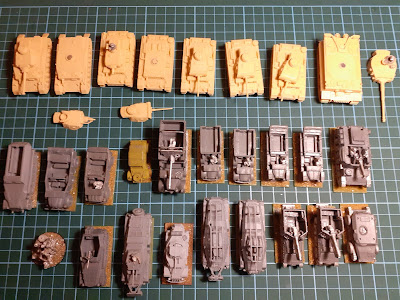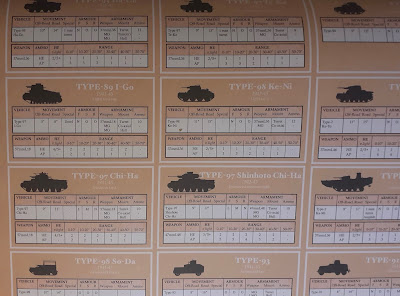So a new Battlegroup book has arrived and this one is the first step (lets hope there’s more) into the Pacific Theatre, more specifically the Pacific and Far East in 1944-45. This book like the others in the series is by Warwick Kinrade and is a supplement so you do need the separate rule book to play.
Straight away the book is obviously good quality, it’s hard bound and full of background information, period photographs and pictures of miniatures on beautiful tabletops to help inspire you. First up there is a contents page and an introduction by Warwick about what the book is and how he came to make some of the decisions and choices.

Next up, like all the Battlegroup supplements there is an excellent introduction to the actions and forces in the theatre. It’s well written and engaging with numerous interesting sidebars about specific conflicts, events and participants. It always surprises me when I see people complaining on forums about the fact you have to have a rulebook and a theatre specific supplement, these books are excellent value and the background information allows a complete WW2 novice to get a grip on their chosen theatre and have a good fundamental knowledge of the types of conflict you’re trying to represent. Even a knowledgeable WW2 buff will find information they didn’t know or benefit from the succinct and well written recap on the Pacific.
After the background information there is a section on amphibious assaults (it seems the similar to the original Overlord book) with special rules that will allow you to represent the Amtracs, DUKW’s and landing craft desperately battling to shore in an attempt to secure a foothold on the island of your choice. Next there is a section on the theatre specific rules that give the real flavour of the conflict and how it differs from say Normandy or Tunisia. This covers things like the use of direct lay mortar fire, combat shotguns, lunge mines and Nikaku teams and even a close protection team for an M3 Grant tank (a group of chaps that occupy the back deck of the tank and use their sub-machine guns to keep enemy infantry away from their precious ride). There is the expected Banzai rules which seem very well thought out and this sections hints at the fact that these battles are going to be very different from other games of Battlegroup I’ve played so far.

After the theatre specific rules there’s a description of the new counters (the system that makes Battlegroup such a fun, tense and dare I say realistic game - as realistic as pushing little metal dollies around a table could be) and their effects. Whilst some supplements share counter sets the Pacific one is a new and unique set that instils the flavour of the island hopping or jungle fighting that went on.
Next up the book has 5 force organisation charts. Two for the Imperial Japanese Army in 44-45 (an Infantry division list with adjustments for playing in Burma and an Island garrison force), two for the US (a Marine Corps list and an infantry division list) and a list for the British in Burma (later in the book in a separate section on Burma as it’s quite different to the island hopping campaigns) with adjustments to represent the Australians. It’s very noticeable that these battles will be very infantry-centric and armour is not as prolific as most other theatres. Whilst the American and British have Grants, Sherman, Stuarts and Matildas the Japanese armour is scarce and out dated. If you’re a fan of tanks then this theatre may not be your favourite but it does allow the importance and actions of the poor bloody infantry to shine (also the forces will/should be easier to collect as unlike say, the Germans in 1944 you won’t need umpteen numbers of various armoured vehicles to allow you to field just a few representative forces, a couple of tanks should cover most of your needs).
The army lists are exactly what you’d be used to with this system but the lists have some excellent thematic units like war dogs for the marines (gives you scout2), amphibious landing craft and AFVs or the discussed close protection teams for British Grants. It’s the Japanese lists that are the most interesting. As the period covered is when the Marines are on a roll and the Japanese are effectively retreating or fighting to the last man. There are ways to add BR to your overall rating or diminish the war weary Americans as they lose the will to keep grinding against a force of fanatics that already consider themselves dead. There is the option for a Japanese Last Remnants platoon where the poor chaps have very few if any firearms (and often no ammo) and have to rely on the trusty bit of sharpened bamboo to defend themselves with.

The Japanese defences section is really characterful from spider holes with varying occupants, to numerous booby traps or concealed caves that allow multiple infantry units to appear as if from no where.
After the lists is a section covering specific terrain - jungle and assorted undergrowth. This is very different to the scenery used for the European theatre and really hammers home the problems for vehicles and infantry fighting in such a complex environment. As a table you are going to need a lot of trees and undergrowth to get the feel for what you’re trying to represent (people always seem to ignore terrain but it really is the third army on the tabletop and generally the better the terrain the more fun the game IMHO).
Next up is 5 scenarios ranging from Amphibious assault, to taking/holding a beach stronghold or overlooking fire base and then the fight through dense jungle and the importance of taking and holding key hills. Like all the Battlegroup scenarios they have a map, background information and any specific rules and example forces to fight it out (but you can always adjust these to fit your collection) and whilst these are specifically ‘Pacific’ in flavour many if not most of the scenarios throughout the series of books can be adapted to fit your chosen battlefield.
After this is the section on Burma, with its own background information and the British infantry division list with a helpful addition to allow you to represent the mighty Australians.
Finally you have the standard Appendix covering the weapons and vehicles of both sides, quick reference sheets and the all important BR counters. Also you get to see the first vehicle reference cards for the Japanese.
So that’s about it for this ‘quick’ look at Battlegroup Pacific. I’m really excited for it and whilst I’m still working on Overlord (and into the Reich) and Tunisia I can see how it should complement these other two theatres and provide a third and different experience. If you haven’t tried Battlegroup I can’t recommend it enough, it’s straightforward but feels engaging and has strong flavour. It works on different sizes from small squad games up to platoons and above, with each size giving a fun, playable experience.
I hope this has been of some use and if you want a copy it can be bought from The Plastic Soldier Company’s website
here. Apologies for the bad photography as I’m down to one hand (your palm can burst if you hit it hard enough, something I found out this week) which is going to slow down my already ambling hobby speed but at least I’ve got a new book to digest.
Stay safe and well, feel free to comment or ask me any questions about the book,
BALM



















